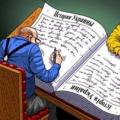Presentation "Dragonfly and Ant" presentation for a reading lesson (4th grade) on the topic. Presentation on literary reading "I.A.

A fable is a literary genre in the form of a short story, often poetic, always of a moralizing nature. At the beginning or at the end of the work, a conclusion is formulated, the main instructive idea is morality. The heroes of the fable are people, animals, plants, birds, fish, things. is a literary genre in the form of a short story, often poetic, always of a moralizing nature. At the beginning or at the end of the work, a conclusion is formulated, the main instructive idea is morality. The heroes of the fable are people, animals, plants, birds, fish, things.


“The Traveler and the Viper” The fable shows that the evil soul not only does not pay gratitude in return for good, but even rebels against the benefactor. The fable shows that the evil soul not only does not pay gratitude in return for good, but even rebels against the benefactor.



WRITE IT DOWN. REMEMBER. A fable is a short story in verse or prose of a moralizing nature with a moral conclusion. A fable is a short story in verse or prose of a moralizing nature with a moral conclusion. Allegory is an allegorical depiction of objects or qualities of people. Allegory is an allegorical depiction of objects or qualities of people. Moral is a lesson, a conclusion at the beginning Moral is a lesson, a conclusion at the beginning or end of a fable. or at the end of a fable.








The relationship between moral fables and proverbs. Write down the fables that are close to morality. 1. Your own land is sweet in a handful. 2. Skill and labor will grind everything down. 3. You won’t get bread by self-indulgence. 4. Good brotherhood is dearer than wealth. 5. Without science is like without hands. 6. Prepare a sleigh in the summer and a cart in the winter. 7. Alone in the field is not a warrior. 8. The sun paints the earth, and labor paints man.


Vocabulary work. Need – zәrulik, mұқtazhdyk Need – zәrulіk, mұқtazhdyk depressed – upset, depressed depressed – sad, depressed spring days – spring days spring days – spring days murava – young grass murava – young grass darling – koketai darling – koketai godfather, godmother - Tamyr godfather ,gossip - tamyr dance - dance dance - dance



Homework 1. Write a letter from the Dragonfly to the Ant 1. Write a letter from the Dragonfly to the Ant begins with the words: “Hello, godfather, begins with the words: “Hello, godfather, half the winter has already passed...” 2. Read the following fable, find 2 Read the following fable, find the moral. morality.


“Music in Krylov’s fables” - You and the bass, Mishenka, sit opposite the viola. First, the main thing in the fable is the comedic introduction. Family of Ivan Andreevich Krylov. Ivan Andreevich's love for music was clearly reflected in his fables. Vanyusha loved to go to the market, where one day he saw an old Italian man. The Nightingale happened to fly to their noise.
“Krylov’s Fables for 4th grade” - Ivan Andreevich Krylov. Heroes of Krylov. Famous fabulists. Match the familiar fables of I.A. Krylov with popular expressions. Do some research on the fable. Favorite pages. Pages of the biography of I.A. Krylov. Fables by I.A. Krylova. Aesop. The language of the fable. Let's check ourselves. What is a fable? Do you know the fables of I. A. Krylov.
“Krylov’s fables about 1812” - Acrostic. Reflection of historical events. Lexical work. Commentary by historians. Parable. Fable. Fable "Wolf in the Kennel". History of the event. Events of 1812. Patriotic War. Historical commentary. War with Napoleon. Ivan Andreevich Krylov. Allegories. Kutuzov. How Krylov depicts the political situation.
“Krylov’s Fables 5th grade” - At the origins of the genre. From 1783 he served in the Treasury Chamber in St. Petersburg and was actively engaged in self-education. Left: I. A. Krylov. Slide numbers. Aesop is an ancient Greek fabulist (VI century BC), considered the creator of the fable. G. Kupriyanov. V. I. Maikov. The teaching was easy for Krylov. Let's work on the language of the fable.
"Dragonfly and Ant"- Suddenly winter comes. Let me gather my strength and feed and warm me until the spring days!” Who can be called a fabulist? Dragonfly and Ant. Algorithm for reading the fable: “Don’t leave me, dear godfather! I.A. Krylov “Dragonfly and Ant” I.I. Khemnitser “Dragonfly” L.N. Tolstoy “Dragonfly and Ants”. Review questions.
"Krylov's Fables"- “The Cuckoo and the Rooster.” Aesop. Velazquez Diego. Ivan Andreevich Krylov (1768-1844). "The Wolf and the Lamb." "Elephant and Pug." "Quartet". Monument to I.A. Krylov in Moscow in the summer garden. "The Fox and the Grapes." "The monkey and the glasses." Monument to I.A. Krylov in St. Petersburg. There is a sculpture on the patriarch's ponds dedicated to Krylov's fables.
Time for business is time for fun.

Guess what literary genre we will study in today's lesson?
Small volume
Animal or plant characters
Animals are spoken of as people
Often poetic form
Instructiveness

Fable – this is a short ___________, in which ___________________________ are acted upon, and _ are implied ________ ______,
their __________________.
In fables they ridicule _____________ _____ of people: _____________
___________________________________________.
The fable contains a moral lesson -
The purpose of fables is
animals, plants
actions, behavior
flaws
envy, greed, laziness
name the vice, educate with a negative example.

Guess the riddle and solve the rebus
Who are they? Where? Whose? Black streams flow. Small dots together They are building a house on a hillock.


Ivan Andreevich Krylov
(1769 - 1844)
Russian writer, fabulist, academician of the St. Petersburg Academy of Sciences (1841). He published satirical magazines “Mail of Spirits” (1789) and others. He wrote tragedies and comedies, opera librettos. In 1809 - 1843 created more than 200 fables, imbued with a democratic spirit, distinguished by satirical sharpness, bright and apt language. They exposed social and human vices. N.V. Gogol called I. Krylov’s fables “...the book of wisdom of the people themselves.”





The pure field has died -
the fields are empty, the birds are not singing, the insects are hiding. There is dead silence in the field.

Explain the lexical meaning of words and expressions
winter has come quickly
Winter is rolling in your eyes -

upset, offended,
Angry melancholy depressed -
Spring days are spring days when streams gurgle.
Godfather, (gossip) - in those days this was how they addressed a familiar man (woman)

MORALITY
Did you sing everything? This business:
So come and dance!
Go for a walk, but don't go on a walk!

DANCE A MINUTE
In the morning the Dragonfly woke up,
She stretched, smiled,
I washed myself with dew,
Two - spun gracefully,
Three-bent over and sat down,
At four I flew,
Stopped by the river
Spun over the water.

Work in groups.
Group 1 - describe the Ant
Group 2 - describe the Dragonfly

Describe the characters in the fable
frivolous...
The ant is fair...
prudent...
carefree...
hardworking...
not serious...
Dragonfly is true...
carefree...


- Learn by heart Krylov's fable "The Dragonfly and the Ant"
- Draw one of the heroes.
- Who else wrote the fable “The Dragonfly and the Ant”? (Internet)

THANK YOU!
SUCCESS!

Monument to Krylov in the Summer Garden
While working on the monument to Krylov, the house of the sculptor Klodt housed a whole menagerie: a donkey, a cat, dogs, a wolf, monkeys, a sheep with lambs, a fox, a crane, a frog and many others.

The long-awaited bell is given, the lesson begins.
Please come to us without delay.
Help us to work hard, We came here to learn.

What works are these illustrations for? ?


« I love where there is opportunity
pinch vices"
I.A. Krylov

Fable
- is a literary genre with a short form of storytelling,
- where animals, birds, things act, and people are meant by them, their vices are ridiculed.
- There must be a moral in a fable,
which most often stands out as an independent part of it and is located either at the beginning or at the end of the fable.

Warm-up
Without work, even kill me,
An ant cannot live.
Over the meadow where the goats graze,
Dragonflies flutter on transparent wings.

Gorgeous
windy
carefree
cheerful
Caring
Smart
hard worker


LESSON QUESTION :
Moral of the story
I.A. Krylova “Dragonfly and Ant”.

Cover layout
I. A. Krylov
Dragonfly and
ant

Not scary
not knowing something.
The main thing is to understand
how to find the information you need,
from what sources?

How to work in pairs.
- Work together.
- Feel free to express your opinion.
- Respect the opinion of others.
- Listen patiently to the thoughts of others.
- Find the right solution together.

- 1. What is the name of the fable? Who is its author? Is it written in poetry or prose?
- 2. Who are the main characters in the fable?
- 3. How are the heroes of the fable shown? Read how the author describes them.
- 4. What is condemned in the fable?
- 5.What unfamiliar words and expressions were found in the fable?

Relate.
My head turned.
Winter is upon us.
There is dead silence in the field
I forgot about everything.
In our soft ants.
I didn’t have time to look back.
I don't want to think.
Suddenly winter came.
It will go into your mind.
It passed quickly.
The pure field is dead.
He's sad.
The angry one is depressed.
In our soft grass.


This is important to know
- Irony is a subtle, hidden mockery
- Allegory is an allegory.

Moral of the story
“Have you been singing everything? This business:
So go and dance!”

Collect proverbs
- Hurry up, time for fun.
- It's time to work, you'll lose the last one.
- If you want a lot, you will make people laugh.
- Which of the characters in the fable did you sympathize with?


AND . I. Khemnitser, L. N. Tolstoy

Comparison of fables.
Text recording form. (poetry, prose)
Moral of the story
Allegory (hard work, frivolity, greed, mercy)

Homework
- Expressive reading of fables by role.
- Come up with your own ending to the fable, if the Ant did let the Dragonfly live with him, draw an illustration for the fable.
- Expressive reading of a fable by heart.

I think that today in class...
Everything worked out for me, I'm happy with my work.
I didn't succeed, but I'm happy with my work.
I know the theoretical material well, but in practical work I did not succeed in everything.
It was difficult and unclear to me.

 Falsification of Russian history
Falsification of Russian history Using the properties of roots when transforming irrational expressions, examples, solutions
Using the properties of roots when transforming irrational expressions, examples, solutions Zinc oxide is an important compound in industry and medicine.
Zinc oxide is an important compound in industry and medicine.